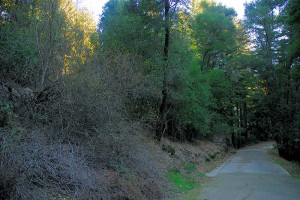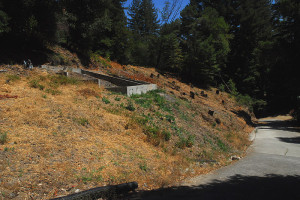Many people think that California would be the perfect place to live. Yes, the weather is wonderful most of the year, especially along the coast here, but to live in California means you have to accept some elements of risk. Some areas are certainly more susceptible to nature’s wrath here than others, and living here in Santa Cruz demands that you’re tough enough to cope with what nature throws at you.
Although it happened almost 20 years ago now, we certainly remember the 1989 Loma Prieta Earthquake very well, although we were living closer to San Francisco at that time. I had just traveled eastbound across the Oakland Bay Bridge, on the lower deck, less than 15 minutes before the upper bridge deck collapsed. As bad as the damage seemed near San Francisco, Santa Cruz was especially hard hit during that quake, and when we first moved to Santa Cruz in 1993, significant parts of the downtown were still being rebuilt. Then there was the El Niño winter of 1997/8. It could have been worse, a lot worse…it certainly wasn’t as bad as the 1982 floods that wreaked monsterous havoc across the county. However, our house did flood in February 1998, when the San Lorenzo river opted to take a detour through our living room. We’ve lived through earthquakes, floods…and then there are the wildfires.
As some of you know, the ‘Lockheed fire’ in Santa Cruz, near Swanton, started on the evening of August 12th, 2009 around 7:15 PM. The next morning a friend and I drove down the coast to Monterey to run a few errands. When we left Santa Cruz that morning we could see some smoke billowing up over the mountains, and drifting out over Monterey Bay. Once we arrived in downtown Monterey, we could smell the smoke, and actually see fine ash particles floating in the air. Then on the trip home just a few hours later, as we approached Santa Cruz, it was clear the fire had grown significantly. Traveling along Highway 1, northbound, there was no question which direction the fire was, as an enormous, billowing, orange smoke cloud loomed over the highway, covering the sun. As I was a passenger that day, I grabbed my cell phone and snapped a photograph as we approached the intersection of Hwys 1 and 17 (above). As of today, more than 7000 acres of land have burned here along the coast. The thick smoke lingers in the air long after the morning fog has retreated. Thankfully there has been no significant loss of personal property, unlike last year’s fires, and no loss of life associated with this fire, primarily because it is burning in very steep, relatively uninhabited, coastal terrain.
So as the fire raged on, on Saturday morning we were hoping to start placing the posts for the deer fence on the orchard hillside. However, the weather conditions made the smoke so oppressive that day, the air quality so poor, that we didn’t think it was wise to exert ourselves outside. Instead we ran a few errands related to the irrigation system that will be installed in the orchard, and in the vegetable gardens. We purchased some PVC water pipe, and our Netafim 1/2 inch dripline for the orchard. Netafim was recommended to us by the University orchardists at UC Santa Cruz, as it’s designed to be installed under grass sod, and is resistant to clogging, which should help reduce maintenance once it’s installed. We spent the rest of the afternoon finalizing the planting plan for the orchard, and the raised box arrangements and crop rotation schemes for the vegetable garden. Because of the variety of vegetables that will be planted, all with different watering needs, we’ve mapped out a minimum of 6 watering zones for the vegetable garden area. The orchard however should only require 2 watering zones, and that part of the system should be easier to install.
So here we sit, chomping at the bit, waiting for the smoke to clear. As you can see below we’ve cleared the hillside, and we know we have to hustle to get the orchard fenced, and get the irrigation in, so we can plant the poor fruit trees that are STILL in pots on our deck, and establish our cover crop of crimson clover before the rainy season starts.
We also need to install straw wattles along the now bare slope, and mulch the entire hillside with straw to both protect the seed, and minimize erosion during this winter.
The past few winters have been very dry here, but this next winter may see the end of our drought. According to a recent press release from NOAA, “nearly all of the dynamical models predict a moderate-to-strong El Niño during the Northern Hemisphere Winter 2009-10.”
We’re looking forward to seeing the end of this drought cycle, but certainly a little wary of what winter could bring if we get too much rain all at once. All we can do is be as prepared as we can be, and see what nature throws at us next…












Well done Clare and Jon. What an inspiration you both are to us! Our irrigation system currently consists of two watering cans and several leaking hoses! Keep up the good work. Look forward to the next installment, so we can nick all your ideas :o) Hope to see you out here soon. Lots of love, J and P XXX
Well done you guys! I’m so glad the fire did not affect you adversely. Nature can be cruel and kind, but I’m glad in this case that it was kind. Your property is GORGEOUS! I hope we get to see it sometime!
XOXO Lorraine